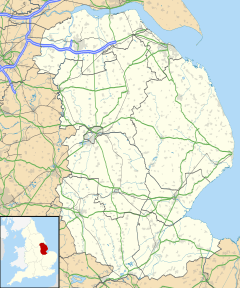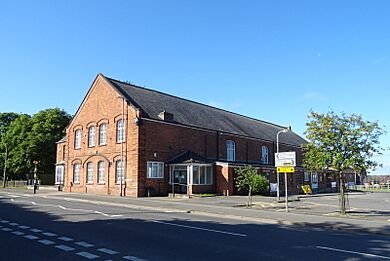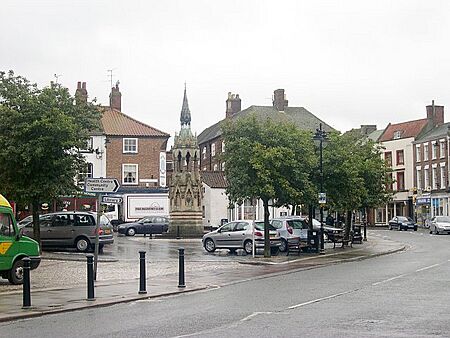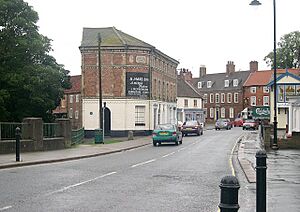Horncastle facts for kids
Quick facts for kids Horncastle |
|
|---|---|
| Town and civil parish | |
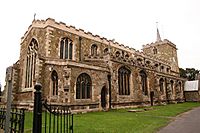 St Mary's Church, Horncastle |
|
| Area | 5.73 km2 (2.21 sq mi) |
| Population | 7,291 (2021) |
| • Density | 1,272/km2 (3,290/sq mi) |
| OS grid reference | TF2669 |
| • London | 115 mi (185 km) S |
| Civil parish |
|
| District | |
| Shire county | |
| Region | |
| Country | England |
| Sovereign state | United Kingdom |
| Post town | HORNCASTLE |
| Postcode district | LN9 |
| Dialling code | 01507 |
| Police | Lincolnshire |
| Fire | Lincolnshire |
| Ambulance | East Midlands |
| EU Parliament | East Midlands |
| UK Parliament |
|
Horncastle is a busy market town in Lincolnshire, England. It's located about 17 kilometers east of Lincoln. In 2021, around 7,291 people lived there.
This town has a long history. You can still see parts of its ancient Roman walls today. Horncastle is also known for its old horse fairs and its many antique shops.
Contents
- Discover Horncastle's Past
- Horncastle's Population Over Time
- Horncastle's Location and Surroundings
- Who Lives in Horncastle?
- Local Businesses and Organizations
- Education in Horncastle
- Getting Around Horncastle
- Local News and Media
- Sports in Horncastle
- Flooding in Horncastle
- Horncastle's Twin Town
- Famous People from Horncastle
- See also
Discover Horncastle's Past
Roman History: Banovallum
Horncastle was once a Roman settlement. It was likely important because of the River Bain. Some people call Roman Horncastle Banovallum. This name means "Wall on the River Bain."
However, we are not completely sure if this was its original Roman name. It was suggested in the 1800s from an old list of Roman towns. The name 'Horncastle' first appeared in the Domesday Book in 1086. It means "the Roman fort in the tongue of land" between the River Bain and River Waring.
You can still see parts of the Roman walls today. One section is even inside the town's library! The Saxons called the town Hyrnecastre, which is where its modern name comes from.
Horncastle in the Domesday Book
In 1086, Horncastle was listed in the Domesday Book. This was a big survey ordered by King William. The town had 41 households, including farmers and small landowners. It also had meadows and two mills. All of this belonged to the King.
St Mary's Church: A Historic Building
The Anglican parish church dates back to the 13th century. It is dedicated to St Mary the Virgin. The church is a Grade II* listed building, meaning it's very important. It was restored between 1859 and 1861.
The English Civil War and Local Legends
Just four miles away is the village of Winceby. In 1643, the Battle of Winceby took place there. This battle helped Parliament gain control of Lincolnshire. Oliver Cromwell, a famous leader, almost died in this battle.
There's a local story about 13 scythe blades in St Mary's Church. People say they were used as weapons at Winceby. However, historians think they are more likely from the Lincolnshire Rising of 1536.
Horncastle's Famous Market and Horse Fair
Horncastle received a special permission to hold a market in the 13th century. For a long time, it was famous for its huge August horse fair. This fair was a very important trading event. It continued until the mid-20th century. The fair stopped after the Second World War, as horses were no longer widely used on farms.
The annual horse fair probably started in the 1200s. It would last for a week or more every August. In the 1800s, it was likely the biggest horse fair in the United Kingdom. The saying "Horncastle for horses" showed how important the town was for horse trading. The last fair was held in 1948. Today, Horncastle is still known for its many antique shops.
In 1894, the Stanhope Memorial was built in the Market Place. It remembers Edward Stanhope MP and is a Grade II listed structure.
Important Buildings in Town
The Old Court House on Louth Road was built in 1865. It is a Grade II listed building. There are 116 other listed buildings in Horncastle. These include the three churches and parts of the Roman walls. The former Horncastle Town Hall was built around 1903.
Horncastle's Population Over Time
Historically, Horncastle's population went down from the mid-1800s to the mid-1900s. This happened as people moved to cities for work. However, since the late 20th century, the population has grown. In 2011, it reached 6,815, which was its highest point then. By 2019, the population was estimated to be even higher at 7,123.
| Population of Horncastle civil parish | |||||||||||||||
|---|---|---|---|---|---|---|---|---|---|---|---|---|---|---|---|
| Year | 1801 | 1811 | 1821 | 1831 | 1841 | 1851 | 1881 | 1891 | 1901 | 1911 | 1921 | 1931 | 1951 | 1961 | 2011 |
| Population | 2,015 | 2,602 | 3,058 | 3,988 | 4,521 | 5,017 | 4,818 | 4,374 | 4,038 | 3,900 | 3,459 | 3,496 | 3,809 | 3,771 | 6,815 |
Horncastle's Location and Surroundings
Horncastle is located near the A158 road. This road connects Lincoln to Skegness. The town is also where the River Bain meets the River Waring. It's north of the West and Wildmore Fens. The Viking Way, a long-distance walking path, also goes through the town.
Who Lives in Horncastle?
At the 2021 census, Horncastle's population was 7,291. Most residents were White (97.8%). The main religious group was Christian (55.1%). Many people also reported having no religion (43.5%).
Local Businesses and Organizations
Several important groups are based in Horncastle. The Lincolnshire Integrated Voluntary Emergency Service is here. The Lincolnshire Wildlife Trust also has its office in Banovallum House. Mortons of Horncastle is a big national magazine publisher. They print magazines about classic motorcycles and transport history.
Education in Horncastle
Horncastle has several schools for different age groups.
Primary School
Horncastle Primary School is located on Bowl Alley Lane.
Secondary Schools
Queen Elizabeth's Grammar School was founded in 1571. It is one of the top schools in Lincolnshire. Its sports teams, like tennis and hockey, compete regionally. The school specializes in Science and Languages.
The Banovallum School is a community school for Horncastle and nearby villages. It works with Queen Elizabeth's Grammar School as a science specialist school. In 2019, Ofsted rated the school as "good." A new building was added in 2010 for subjects like cooking, woodwork, and music.
St Lawrence School is a special-needs school. It helps students from all over the county.
Getting Around Horncastle
Roads and Traffic
Horncastle is at a crossroads of two main Lincolnshire roads. The A158 road goes east-west, connecting Lincoln to Skegness. The A153 road goes north-south, linking Louth with Sleaford and Grantham. These roads meet in the town center.
The A158 can get very busy in the summer. Many holidaymakers use it to get to Skegness. To help with traffic, a bypass called Jubilee Way was built in the 1970s. Horncastle is also a hub for the InterConnect rural bus service. This service offers regular buses to Lincoln, Skegness, and across the Wolds.
Horncastle's Railway History
A branch railway line to Horncastle opened in 1855. It connected to the main Lincoln–Boston line. The last passenger train ran in 1954. The line fully closed for goods in 1971. Horncastle railway station was taken down in the 1980s. Now, houses stand where it used to be. Part of the old railway path is now used by the Viking Way footpath.
Horncastle Canal
The Horncastle Canal, which uses the River Bain, was built between 1792 and 1802. In 2004, people suggested fixing up the canal. The idea was to use it for pleasure craft, like boats for fun. Local groups have raised money to help with this project.
Local News and Media
For local news and TV, Horncastle gets its signals from BBC Yorkshire and Lincolnshire and ITV Yorkshire. You can also listen to local radio stations like BBC Radio Lincolnshire. The Horncastle News is the town’s weekly local newspaper.
Sports in Horncastle
Horncastle has several sports clubs for different games.
Field Sports
Horncastle Town FC is a football club founded in 1873. They play at The Wong. The town's cricket club at Coronation Walk has teams for both adults and young people. Horncastle Hockey Club started in 1970. It has men's, women's, and junior teams.
Court Sports
Horncastle and District Tennis Club has been around for over 70 years. It moved to its current location at Coronation Walk in the 1970s. The Horncastle Community Members Squash Club was started in 2006. It was created to keep an existing squash club going.
Flooding in Horncastle
Horncastle has had problems with flooding in the past. Big floods happened in 1920 and 1960. There were also three floods between 1981 and 1984.
Some local stories connect floods to when new vicars start at the Anglican Church. For example, the vicar changed in 1919 and 1959, just before floods. The floods in the early 1980s were also linked to a new vicar starting in 1980. However, there was no flooding after the vicar changed in 1999. The River Bain and River Waring overflowed during the 2007 United Kingdom floods. Flooding happened again in 2012. New flood defenses are being discussed to help protect the town. An anti-flood pump was put in place in 2013.
On October 7, 1960, Horncastle had a record rainfall. It received 178 millimeters of rain in just three hours. Water levels reportedly rose by 8 feet.
Horncastle's Twin Town
Horncastle is twinned with Bonnétable. This is a market town in France with about 4,000 people. To celebrate this friendship, there is a Rue Horncastle (Horncastle Street) in Bonnétable. In Horncastle, there is a Bonnetable Road.
Famous People from Horncastle
Many notable people have connections to Horncastle:
- William Blaxton (1595–1675) was an early English settler in New England. He was the first European settler of modern-day Boston.
- Sir Joseph Banks (1743–1820) was a famous botanist who traveled with Captain James Cook.
- Annie Dixon (1817–1901) was a talented miniature portrait painter.
- William Marwood (1818–1883) was a public hangman.
- Ben Pridmore (born 1976) is a memory champion who went to school in Horncastle.
- Samuel Roberts (1827–1913) was a mathematician and a member of the Royal Society.
- Thomas Sully (1783–1872) was a well-known portrait painter.
- Emily Tennyson, Lady Tennyson (1813–1896) and Alfred, Lord Tennyson (1809–1892) are also connected to the area. Alfred, a famous Poet Laureate, was born nearby.
- Robert Webb (born 1972), an actor and comedian, went to school in Horncastle.
See also
 In Spanish: Horncastle para niños
In Spanish: Horncastle para niños


